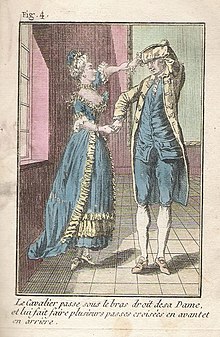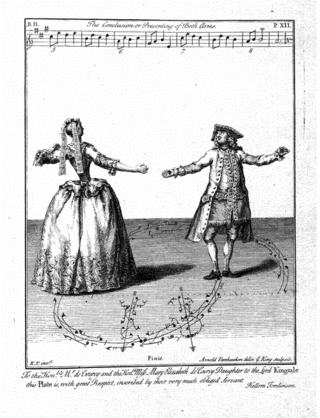
Baroque dance is dance of the Baroque era, closely linked with Baroque music, theatre, and opera.
In musical terminology, tempo also known as beats per minute, is the speed or pace of a given composition. In classical music, tempo is typically indicated with an instruction at the start of a piece and is usually measured in beats per minute (“bpm”). In modern classical compositions, a "metronome mark" in beats per minute may supplement or replace the normal tempo marking, while in modern genres like electronic dance music, tempo will typically simply be stated in BPM.

A suite, in Western classical music, is an ordered set of instrumental or orchestral/concert band pieces. It originated in the late 14th century as a pairing of dance tunes and grew in scope to comprise up to five dances, sometimes with a prelude, by the early 17th century. The separate movements were often thematically and tonally linked. The term can also be used to refer to similar forms in other musical traditions, such as the Turkish fasıl and the Arab nuubaat.

The rondo is a musical form that contains a principal theme which alternates with one or more contrasting themes, generally called "episodes", but also occasionally referred to as "digressions" or "couplets". Some possible patterns include: ABACA, ABACAB, ABACBA, or ABACABA.
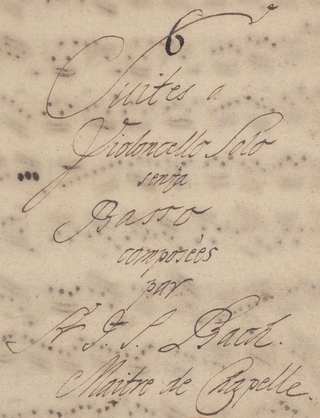
The six Cello Suites, BWV 1007–1012, are suites for unaccompanied cello by Johann Sebastian Bach (1685–1750). They are some of the most frequently performed solo compositions ever written for cello. Bach most likely composed them during the period 1717–1723, when he served as Kapellmeister in Köthen. The title given on the cover of the Anna Magdalena Bach manuscript was Suites à Violoncello Solo senza Basso.

The gavotte is a French dance, taking its name from a folk dance of the Gavot, the people of the Pays de Gap region of Dauphiné in the southeast of France, where the dance originated, according to one source. According to another reference, the word gavotte is a generic term for a variety of French folk dances, and most likely originated in Lower Brittany in the west, or possibly Provence in the southeast or the French Basque Country in the southwest of France. It is notated in 4
4 or 2
2 time and is usually of moderate tempo, though the folk dances also use meters such as 9
8 and 5
8.

The sarabande is a dance in triple metre, or the music written for such a dance.
Johann Caspar Ferdinand Fischer was a German Baroque composer. Johann Nikolaus Forkel ranked Fischer as one of the best composers for keyboard of his day; however, partly due to the rarity of surviving copies of his music, his music is rarely heard today.
Johann Jakob Froberger was a German Baroque composer, keyboard virtuoso, and organist. Among the most famous composers of the era, he was influential in developing the musical form of the suite of dances in his keyboard works. His harpsichord pieces are highly idiomatic and programmatic.
The courante, corrente, coranto and corant are some of the names given to a family of triple metre dances from the late Renaissance and the Baroque era. In a Baroque dance suite an Italian or French courante is typically paired with a preceding allemande, making it the second movement of the suite or the third if there is a prelude.
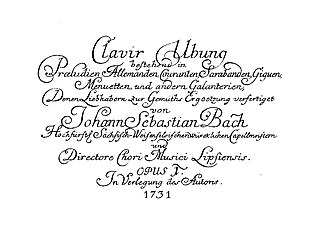
The Partitas, BWV 825–830, are a set of six keyboard suites written by Johann Sebastian Bach, published individually beginning in 1726, then together as Clavier-Übung I in 1731, the first of his works to be published under his own direction. They were, however, among the last of his keyboard suites to be composed, the others being the six English Suites, BWV 806-811 and the six French Suites, BWV 812-817, as well as the Overture in the French style, BWV 831.

The English Suites, BWV 806–811, are a set of six suites written by the German composer Johann Sebastian Bach for harpsichord and generally thought to be the earliest of his 19 suites for keyboard, the others being the six French Suites, the six Partitas and the Overture in the French style. They probably date from around 1713 or 1714.

The French Suites, BWV 812–817, are six suites which Johann Sebastian Bach wrote for the clavier between the years of 1722 and 1725. Although Suites Nos. 1 to 4 are typically dated to 1722, it is possible that the first was written somewhat earlier.
The Overture in the French style, BWV 831, original title Ouvertüre nach Französischer Art, also known as the French Overture and published as the second half of the Clavier-Übung II in 1735, is a suite in B minor for a two-manual harpsichord written by Johann Sebastian Bach.
Orchestral Suite No. 1 in D minor is an orchestral suite, Op. 43, written by Pyotr Ilyich Tchaikovsky in 1878 and 1879. It was premiered on December 20, 1879 at a Russian Musical Society concert in Moscow, conducted by Nikolai Rubinstein. The piece is dedicated to Tchaikovsky's patroness, Nadezhda von Meck.

The term galanteries is sometimes used for movements in the Baroque dance suite whose inclusion is variable, unlike the fixed core of allemande, courante, sarabande and gigue. These pieces usually follow the sarabande.

The six partitas for solo violin by Johann Paul von Westhoff are the earliest known published music for solo violin. Although Westhoff's compositions were rediscovered by scholars already in the mid-19th century, this work was not found until the late 20th century.

Baroque music refers to the period or dominant style of Western classical music composed from about 1600 to 1750. The Baroque style followed the Renaissance period, and was followed in turn by the Classical period after a short transition. The Baroque period is divided into three major phases: early, middle, and late. Overlapping in time, they are conventionally dated from 1580 to 1650, from 1630 to 1700, and from 1680 to 1750. Baroque music forms a major portion of the "classical music" canon, and is widely studied, performed, and listened to. The term "baroque" comes from the Portuguese word barroco, meaning "misshapen pearl". The works of Antonio Vivaldi, George Frideric Handel and Johann Sebastian Bach are considered the pinnacle of the Baroque period. Other key composers of the Baroque era include Claudio Monteverdi, Domenico Scarlatti, Alessandro Scarlatti, Alessandro Stradella, Tomaso Albinoni, Johann Pachelbel, Henry Purcell, Georg Philipp Telemann,Jean-Baptiste Lully, Jean-Philippe Rameau, Marc-Antoine Charpentier, Arcangelo Corelli, François Couperin, Johann Hermann Schein, Heinrich Schütz, Samuel Scheidt, Dieterich Buxtehude, Gaspar Sanz, José de Nebra, Antonio Soler, Carlos Seixas and others.
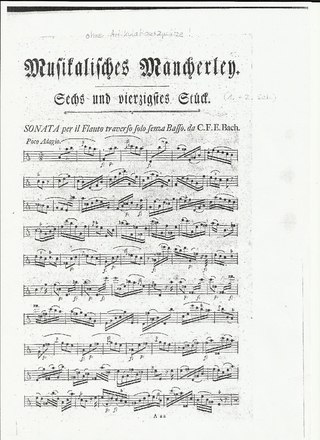
The Sonata for Solo Flute in A minor, Wq.132, H 562, is a sonata for flute, without Basso Continuo or accompanying instruments, composed by Carl Philipp Emanuel Bach. The sonata is considered, along with Telemann's Fantasias for Solo Flute and J. S. Bach's A minor partita, one of the most significant works for unaccompanied flute before the 20th century. It is the sole flute work by Bach that was printed and published during his lifetime. No manuscript of it has been discovered.
